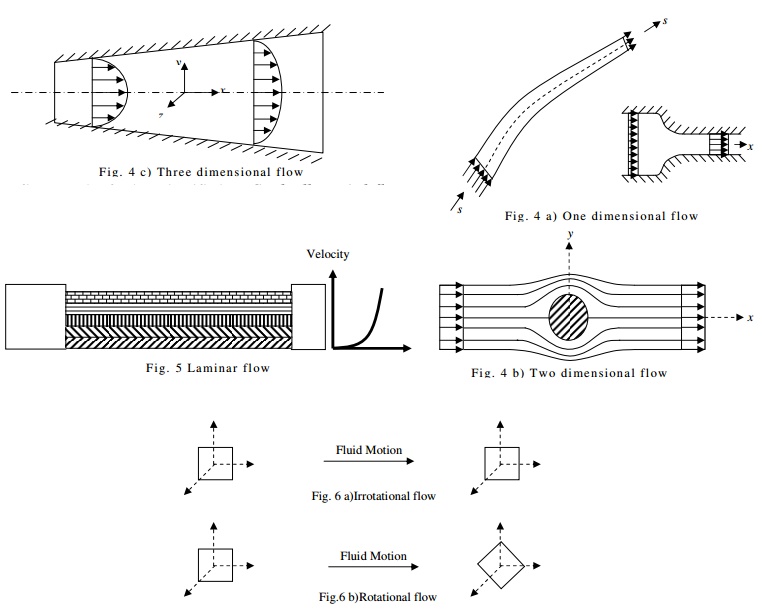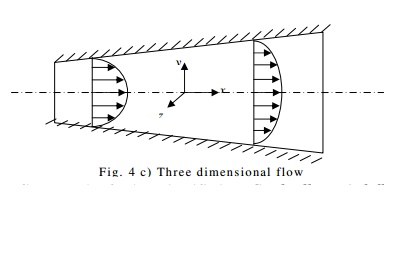Chapter: Civil : Mechanics Of Fluids : Fluid Kinematics And Dynamics
Fluid Kinematics And Dynamics: Classification of Flows

Classification of Flows:
1. Steady and unsteady flows:
A flow is said to be steady if the properties (P) of the fluid
and flow do not change
? ( P) = 0 ?t
with time (t) at any section or point in a fluid flow.
A flow is said to be unsteady if the properties (P) of the
fluid and flow change with
? ( P) ? 0 ?t
time (t) at any section or point in a fluid flow.
Eg: Flow observed at a dam section
during rainy season, wherein, there will be lot of inflow with which the flow
properties like depth, velocity etc.. will change at the dam section over a
period of time representing it as unsteady flow.
2. Uniform and non-uniform flows:
A flow is said to be uniform if the properties (P)
of the fluid and flow do not change (with direction) over a length of flow
considered along the flow at any instant.

A flow is said to be non-uniform
if the properties (P) of the fluid and flow change (with direction) over a
length of flow considered along the flow at any instant.
Eg: Flow observed at any instant,
at the dam section during rainy season, wherein, the flow varies from the top
of the overflow section to the foot of the dam and the flow properties like
depth, velocity etc., will change at the dam section at any instant between two
sections, representing it as non-uniform flow.
Consider a fluid flow as shown
above in a channel. The flow is said to be steady at sections 1 and 2 as the
flow does not change with respect to time at the respective sections (y1=y2
and v1=v2 ).
The flow between sections 1 and 2
is said to be uniform as the properties does not change between the sections at
any instant (y1 =y2 and v1
= v2).
The flow between sections 2 and 3 is
said to be non-uniform flow as the properties vary over the length between the
sections.

Non-uniform flow can be
further classified as Gradually varied flow and Rapidly
varied flow. As the name itself indicates, Gradually varied
flow is a non-uniform flow wherein the flow/fluid
properties vary gradually over a long length (Eg: between sections 2 and 3).
Rapidly varied flow is
a non-uniform flow wherein the flow/fluid properties vary rapidly
within a very short distance. (Eg: between sections 4 and 5).
Combination of steady
and unsteady flows and uniform and non-uniform flows can be classified as steady-uniform
flow (Sections 1 and 2), unsteady-uniform flow, steady-non-uniform
flow (Sections 2 and 3) and unsteady-non-uniform flow
(Sections 4 and 5).
3. One, two and three dimensional
flows:
Flow is said to be direction and will
one-dimensional if the properties vary only along one axis / be constant with
respect to other two directions of a three-

Flow is said to be two-dimensional
if the properties vary only along two axes / directions and will be constant
with respect to other direction of a three-dimensional axis system.
Flow is said to be three-dimensional
if the properties vary along all the axes / directions of a three-dimensional
axis system.
4. Laminar and Turbulent flows:
When the flow occurs like sheets or laminates and
the fluid elements flowing in a layer does not mix with other layers, then the
flow is said to be laminar. The Reynolds number (Re) for the flow
will be less than 2000.

When the flow velocity increases, the sheet like
flow gets mixed up and the fluid elements mix with other layers there by
causing turbulence. There will be eddy currents generated and flow reversal
takes place. This flow is said to be Turbulent.

The Reynolds number for the flow will be greater than 4000.
For flows with Reynolds number between 2000 to 4000 is said to
be transition flow.
5. Compressible and Incompressible
flows:
Flow is said to be Incompressible
if the fluid density does not change (constant) along the flow direction and is
Compressible if the fluid density varies along the flow direction
? = Constant (incompressible) and ? ? Constant (compressible)
6. Rotational and Irrotational flows:
Flow is said to be Rotational if the
fluid elements does not rotate about their own axis as they move along the flow
and is Rotational if the fluid elements rotate along their axis
as they move along the flow direction.

7. Critical, Sub-critical and
Super-critical flows:
Froude's Number
It is the ratio of the inertia forces to gravity
forces and mathematically

where Fe=Froudes No, V is
the flow velocity and d is the hydraulic mean gd depth given by
d-A/T, A is the flow cross-sectional area
and T is the top width.
![]() T
T
If the Foude's number is ONE, the
flow is critical, Less than ONE, Sub-critical and
Greater than ONE, Super-critical.
Rate of flow or Discharge (Q):
Rate of flow or discharge is said
to be the quantity of fluid flowing per second across a section of a flow. Rate
of flow can be expressed as mass rate of flow or volume rate of flow. Accordingly
Mass rate of flow = Mass of fluid
flowing across a section / time Rate of flow = Volume of fluid flowing across a
section / time
Types of lines
Path Line: It is the
path traced by a fluid particle over a period of time during its motion
along the fluid flow.

Eg: Path traced by an ant coming out from its dwelling
Related Topics